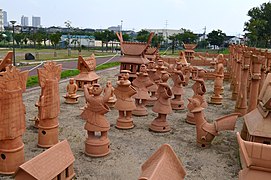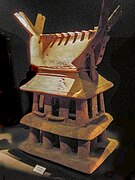Imashirozuka Kofun
The Imashirozuka Kofun ( Japanese 今 城 塚 古墳 ) dates from the first half of the 6th century and is registered as a "National History Trail " ( 国 史跡Kuni shiseki ). It is the largest tomb in the Yodogawa area in Osaka Prefecture in Japan .
Overview
The central area of the tomb, which faces southeast here, has the typical "keyhole shape". It consists of a round part ( 後 円 部 Kōenbu ), which is followed by a triangular ( 前方 Zenbō ). The system here is 190 m long, with the double trenches the total length is 330 m. As for those buried there, previous reviews of the Nihon shoki , Engishiki, and others have shown that Emperor Keitai was most likely buried there.
In 1997, the city of Takatsuki began a large-scale study of the site in connection with the creation of a history park. A large number of Haniwa figures were excavated , which the tomb showed in each case as that of an important person. The Haniwa, which have been excavated from the intermediate ring and which also include house shapes, are the largest of their kind in Japan with a size of 1.70 m. There are 136 pieces in total. They were found in rows or groups from the middle dike up to 6 m outwards, so that it could be a replica of the burial process of a high-ranking person.
About 700 to the northwest, the Haniwa production facility with kilns was found. This site ( 新 池 埴 輪 製作 遺跡 Shinike haniwa seisaku iseki ) is also registered as a national history trail .
photos
literature
- Osaka-fu no rekishi sampo henshu iinkai (Ed.): Imashirozuka Kofun . In: Osaka-fu no rekishi sampo (jo). Yamakawa Shuppan, 2007. ISBN 978-4-634-24627-0 . P. 217.
Web links
Coordinates: 34 ° 51 ′ 0.9 ″ N , 135 ° 35 ′ 39 ″ E




